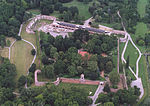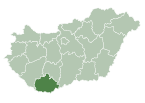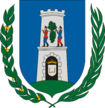Szigetvár
Szigetvár | |
|---|---|
 Aerial Photography: Szigetvár – Main Square | |
 Flag  Coat of arms | |
 Szigetvár | |
| Coordinates: 46°02′54″N 17°48′45″E / 46.048269°N 17.812569°ECoordinates: 46°02′54″N 17°48′45″E / 46.048269°N 17.812569°E | |
| Country | Hungary |
| County | Baranya |
| District | Szigetvár |
| Area | |
| • Total | 39.51 km2 (15.25 sq mi) |
| Population (2009) | |
| • Total | 10,900 |
| • Density | 288.33/km2 (746.8/sq mi) |
| Time zone | UTC+1 (CET) |
| • Summer (DST) | UTC+2 (CEST) |
| Postal code | 7900 |
| Area code | (+36) 73 |
| Website | www |
Szigetvár (Hungarian pronunciation: [ˈsiɡɛtvaːr]; Croatian: Siget; Turkish: Zigetvar; English: Islandcastle; German: Inselburg) is a town in Baranya County in southern Hungary.
History[]


The town's fortress was the setting of the Siege of Szigetvár in 1566. It was a sanjak centre at first in Budin Province (1566–1601), later in Kanije Province (1601–1689).
The former Andrássy Palace is next to them. Some other monuments in the town date back to Ottoman times. Two years after the siege, the mosque of Ali Pasha was built, later – in 1788 – to be transformed into a Christian church: the Roman Catholic parish church. The two minarets, as well as the windows and niches with ogee arches indicate its original function. The Turkish House of red raw brick walls and interlaced steel window grills in Bástya Street was originally destined to be a caravanserai. The two holy-water basins of the Franciscan Church were made of Turkish washbasins. The carved main altar of the Baroque Church is another sight to see. In 1966, on the 400th anniversary of the siege, Szigetvár regained its old rank of a chartered ancient city. Development began to gather speed. Today it has a population of 12,000. In October 2011, the city received the title Civitas Invicta from the Hungarian Parliament.[1]
In 1994, the Hungarian-Turkish Friendship Park (Hungarian: Magyar-Török Barátság Park) was established as a public park, dedicated in memorial to the Battle of Szigetvár.[2]
Archaeological digs conducted by the University of Pécs starting in 2016 revealed the tomb of Sultan Suleiman the Magnificent in the nearby destroyed settlement of Turbék.[3]
Twin towns – sister cities[]
Szigetvár is twinned with:[4][5][6]
 Čakovec, Croatia
Čakovec, Croatia Deva, Romania
Deva, Romania Eppingen, Germany
Eppingen, Germany Imatra, Finland
Imatra, Finland Pag, Croatia
Pag, Croatia Slatina, Croatia
Slatina, Croatia Trabzon, Turkey
Trabzon, Turkey
Gallery[]

Turkish-Hungarian Friendship Park in Szigetvar depicting the two great leaders

A plaque at the Turkish-Hungarian Friendship Park in Szigetvar
See also[]
- Nikola IV Zrinski
References[]
- ^ "Iromány adatai". Parlament.hu. Retrieved 2017-04-02.
- ^ Karikó, Sándor & Tibor Szabó (December 2009). Ferrari, Angelo (ed.). "A Hungarian-Turkish Cultural Heritage: Scandal and Reconciliation". PROCEEDINGS 4th International Congress on "Science and Technology for the Safeguard of Cultural Heritage in the Mediterranean Basin". Cairo, Egypt. 1: 18. ISBN 9788896680315. Retrieved 26 August 2013.
- ^ The Search for the Sultan’s Tomb https://www.archaeology.org/issues/292-1803/letter-from/6344-hungary-search-for-suleiman
- ^ "Testvérvárosok". szigetvar.hu (in Hungarian). Szigetvár. Retrieved 2021-04-10.
- ^ "Međunarodna suradnja". pag.hr (in Croatian). Pag. Retrieved 2021-04-10.
- ^ "Gradovi prijatelji". cakovec.hr (in Croatian). Čakovec. Retrieved 2021-04-10.
External links[]
| Wikimedia Commons has media related to Szigetvár. |
- Official website in Hungarian
- Szigetvár at funiq.hu (in English)
- Populated places in Baranya County
- Baranya (region)
- History of Baranya (region)




